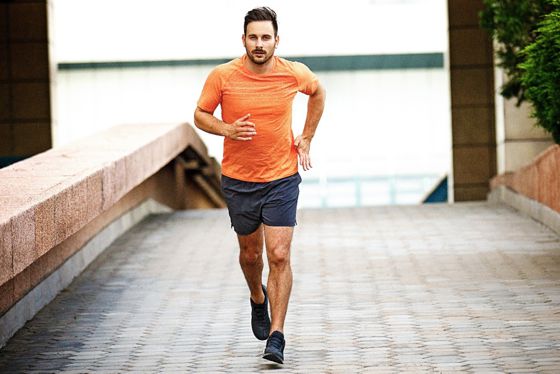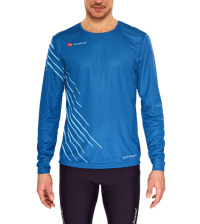All About Aerobic Training
What exactly is aerobic training?

Aerobic training describes endurance sports that are performed at low exertion. The body obtains the energy it needs mainly with the help of oxygen and boosts fat burning. We explain how aerobic training works and which sports are suitable for a workout in the aerobic zone.
- What does aerobic training mean?
- What happens in the body during aerobic training?
- What is the aerobic zone?
- What is the difference to anaerobic training?
- How does aerobic endurance training work?
- Which sports are suitable for aerobic training?
- How do you train in the aerobic zone?
- How can the right intensity be measured?
- Keep fit: start your aerobic training now!
What does "aerobic training" mean?
Aerobic training basically describes endurance sports such as jogging, swimming or cycling. The term "aerobic" comes from the Greek word for air. It refers to the fact that something consumes oxygen or depends on it. It is the same with aerobic training - the body uses oxygen to a large extent to generate energy for the sporting activity. In doing so, it burns fats and carbohydrates as a source of energy.
If you want to train in the so-called aerobic zone, make sure your workout is low to moderate in intensity. When jogging or walking slowly, you are in the aerobic zone. If, on the other hand, you work your muscles harder, the oxygen you take in will not be enough and you will switch to the anaerobic mode.
What happens in the body during aerobic training?
Aerobic metabolism is a way of generating energy in the human body. During light sporting activities, the muscles generate most of the energy they need using oxygen. The production takes longer than with anaerobic training, but a larger amount of energy is released. This means you can do sport over a longer period of time and still have plenty of energy.
During aerobic training, such as light jogging, walking or cycling, the heart and lungs work harder and the body's oxygen consumption increases. The oxygen absorbed is used to break down fats and glucose in particular and used as a source of energy. Aerobic endurance training therefore helps to keep the circulation, heart and lungs healthy. Aerobic exercises also effectively stimulate fat burning. After training, the so-called "afterburn effect" sets in. This means that fat is still broken down after exercise, as the aerobic metabolism continues for a while.
What is the aerobic zone?
The area in which energy is primarily produced using oxygen is known as the aerobic zone. The body remains in the aerobic metabolism as long as the body absorbs sufficient oxygen to supply the muscles. If the load is too high, the so-called lactate threshold is reached. Part of the energy required must now be obtained without oxygen. This process leads to the formation of lactate (lactic acid) as an intermediate product, which results in over-acidification of the muscles and a reduction in performance.

What is the difference to anaerobic training?
Under high levels of stress, the body switches to anaerobic metabolism. This means that there is not enough oxygen available to produce the required energy. During anaerobic training, energy is therefore partly produced without oxygen. Training with short and intensive exertion in particular, for example strength or strength endurance exercises, set the anaerobic metabolism in motion.
At the transition between the aerobic and anaerobic zones, there is the so-called "steady state". Here the oxygen intake is equal to the oxygen consumption. However, training in this narrow range counts as part of the aerobic zone.
Was ist nun besser? A combination of aerobic and anaerobic training is important to build endurance and muscle strength in equal measure.
How does aerobic endurance training work?
Aerobic training is primarily about light sporting activities that keep your body in the aerobic zone. You can find out which sports are suitable for aerobic fitness below.

Which sports are suitable for aerobic training?
Aerobic training is often associated with endurance sports such as running, cycling or swimming. It is important that you keep the load low and perform the sport over a longer period of time. It is usually characterised by rhythmic movements and the use of large muscle groups.
The following sports are suitable for aerobic training:
Our recommendation : You can also do aerobic training on an ergometer or treadmill in your living room at home.
Are you interested in jogging and would like to try aerobic running? Then endurance running is the right choice for you. Stick to a moderate intensity so that you can keep going for at least 30 minutes. Are you a beginner and can't manage 30 minutes yet? Then you will find helpful information on how to start training in our article on learning to jog. In the owayo magazine you will also find tips on the right running technique, interval training for beginners.
In its 2020 report „WHO guidelines on physical activity and sedentary behaviour: at a glance“ (PDF) the WHO (World Health Organization) advises regular exercise, whether on everyday journeys by bike or on foot, at work, at home or during leisure time. It recommends planning at least 150 to 300 minutes of moderate, aerobic exercise per week.
How do you train in the aerobic zone?
Professional athletes use precise lactate measurement to determine the optimal training zone ("steady state"). This is not necessary for amateur athletes - they determine their approximate aerobic zone via the pulse rate.
Always make sure that your heart rate during aerobic training does not exceed 80 percent. The body's fat-burning mode starts at around 60 percent. At a value of 70 to 80 percent of the maximum heart rate, you are in the aerobic zone - this is where endurance is strengthened. To be able to estimate the optimum training zone, you should first determine your maximum heart rate.
The formula according to Winfried Spanaus (sports scientist and author) gives you a rough guide:
- For Men:
Max heart rate = 223 – 0-9 x Age - For Women:
Max heart rate = 226 – Age
It is important to listen to your body, especially as a beginner, and not blindly rely on the numbers. Breathing is a good way to measure whether you have a good pace. If you breathe in for three steps and out for three steps, then your speed is right.

How can the right intensity be measured?
Ideally, you can track the intensity of your training using a heart rate monitor or smartwatch. These often display your heart rate so that you can check whether you are in the aerobic zone. Many models can be connected to an app to track your training and evaluate it afterwards. Some providers even allow you to preset heart rate zones. You can find valuable information on the best sports apps in our magazine.
Keep fit: start your aerobic training now!
Endurance sports such as running, cycling or swimming are suitable for aerobic training, provided you do them over a longer period of time and at a low to moderate intensity. Training in the aerobic zone helps to boost fat burning and increases endurance in the long term.
When would you like to start your aerobic training? We recommend that you buy suitable sports clothing in advance. In our store you will find a large selection of functional clothing for various sports such as running and cycling. With the owayo 3D designer, you can design your own jerseys according to your individual wishes. With the right clothing, you can get the best out of yourself during training.
Want even more training tips? In our magazine you can find out, for example, which running clothes are best suited to your training and what you need to consider when eating before and after exercise. Would you like even more training tips? In our magazine you can find out, for example, which running clothes are best suited to your training and what you need to consider when eating before and after exercise.
Image credits: title image: © lzf/stock.adobe.com, image 1: © grki/stock.adobe.com, image 2: © Jacek Chabraszewski/stock.adobe.com, image 3: © Jacob Lund/stock.adobe.com.

